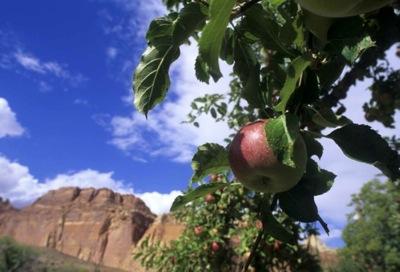
Capitol Reef National Park is an oft-overlooked member of Utah's "Mighty Five" national parks/NPS
There are five national parks in Utah, and Capitol Reef National Park very likely is the one you've never heard about, but the one you definitely should put on your bucket list.
Why? Because seemingly few people have discovered it, and it's not a next door neighbor of any of the other four. And if you like rugged and wild Western landscape that's carved out of the Colorado Plateau, this is the place to head.
A hogback running nearly 100 miles north and south through central Utah is the defining spine of Capitol Reef National Park, but this ruddy landscape offers many more geologic and cultural wonders.
Though the park draws its name from domes of white Navajo sandstone and the angular reefs of rock that reach for the sky, reds, tawny buffs, blacks and browns also paint Capitol Reef. And green, in the form of sweet-scented fruit and nut orchards planted by Mormon settlers late in the 19th century that continue to bear apples, pears, apricots, cherries, plums, mulberries, almonds and walnuts. Those alone are reason enough to visit this national park come harvest season.

Capitol Reef's orchards are a main attraction during the harvest season/Patrick Cone
But any time of year Capitol Reef is a welcome destination for park travelers. The seasons just require different layerings of clothes. It's really not much different than what the landscape goes through. In fall, the golden-leafed cottonwoods clinging to the Fremont River corridor tint the redrock surroundings with their reflections. Winter brings cold and occasional snowfall that also offers a brilliant contrast to the geology. Spring slowy encourages vestiges of life to erupt across the landscape -- Indian rice grass and needle-and-thread along washes, buds on the fruit and nut trees, pink, yellow and red blooms on pricklypear, fishhook, and claret cup cacti, and vibrant Indian paintbrush. And then summer arrives with its blushing fruit hanging heavy in the orchards.
While the Mormon settlers in the 1870s brought the fruit and nut trees, bringing life to the small valley fed by the Fremont River, this land was cultivated a long, long time before they arrived. The Fremont culture inhabited the region from roughly 600-1300 CE, supplementing what they could hunt down with corn, beans and squash. Though they're long gone, their pictographs and petroglyphs remain.
Just as Fruita attracted the Fremont centuries ago, today it lures the bulk of the park's visitors. The 71-site campground, set amid the orchards, is one of the most beautiful in the entire National Park System and a welcome spot to pitch a tent or park your camper. Spring is a great time to do just that, as the warming weather helps green the landscape, lures herds of deer into the orchards, and sends marmots scampering across the meadows. But early fall just might be the best time to camp, as the harvest is in full swing, with juicy apples, peaches and pears yours for the picking.
As rich and welcoming as the Fruita area is, the rest of Capitol Reef is raw and challenging...and beautiful. This is a long, narrow park, one with rather limited vehicle access. To truly explore it, you need a sound four-wheel-drive rig, a comfortable backpack, or both. There are slot canyons, spectacular stone arches, and rock sentinels that reach for the clouds. It's a park that invites close inspection.
Traveler's choice for: Geology, rock art, camping, hiking, photography, harvest time.






Comments
I first visited Capitol Reef in the late '80s, when I was first discovering southwest Utah's marvels on periodic trips from California. I regularly recommend it to people planning a visit to the region, most of whom have never heard of it previously. It's my favorite Utah park.
Capitol Reef is my favorite of the Utah parks! Especially loved the Grand Wash road, which I think most people miss. And the apple pie at the Gifford Homestead is to die for!!
Was a Park Ranger there in the early 1970's; worked at other NPs in the west, as well. My most favorite place in the NPS system...by far!. Everything about it is increditable!
The Grand Wash is interesting. I also enjoyed the hike to above the Cassidy Arch. At the top there is a sunken chamber with trees and shade. It is easy to imagine back to the time that Butch Cassidy (allegedly) hid in this hole.
Well worth the visit. We spent time at Capitol Reef last summer in a trip that also included Canyonlands, also in Utah, and Great Basin in Nevada - parks that can sometimes can be hard to find, even with a map - and GPS, but glad we made the effort. The history that goes with Capitol Reef makes it unique and it's these touches that usually gives each national park its own special appeal. Besides, at how many national parks can you get a piece of freshly made apple pie?